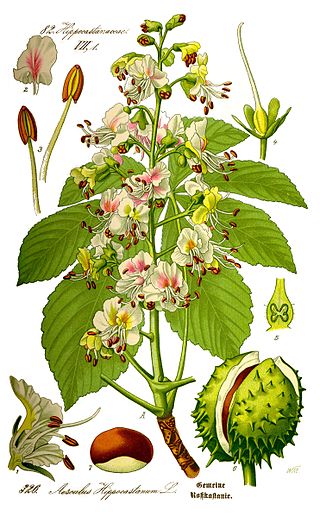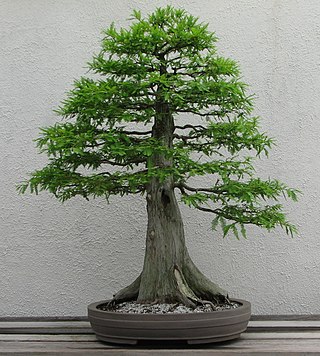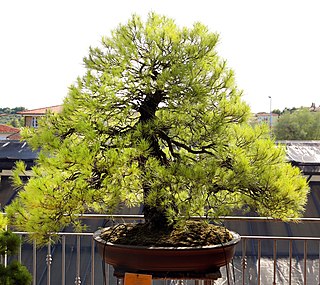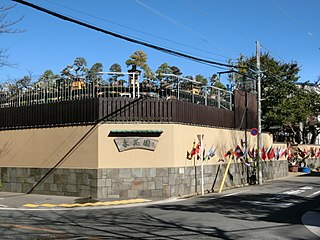Related Research Articles

Bonsai is the Japanese art of growing and training miniature trees in containers, developed from the traditional Chinese art form of penjing. Penjing and bonsai differ in that, the former, attempts to display “wilder,” more naturalistic scenes, often representing landscapes, including elements such as water, rocks or figurines; on the other hand, bonsai typically focuses on a single tree or a group of trees of the same species, with a higher level of aesthetic refinement. Similar versions of the art exist in other cultures, including the miniature living landscapes of Vietnamese Hòn non bộ. It was during the Tang dynasty, when penjing was at its height, that the art was first introduced in Japan.

A hedge or hedgerow is a line of closely spaced shrubs and sometimes trees, planted and trained to form a barrier or to mark the boundary of an area, such as between neighbouring properties. Hedges that are used to separate a road from adjoining fields or one field from another, and are of sufficient age to incorporate larger trees, are known as hedgerows. Often they serve as windbreaks to improve conditions for the adjacent crops, as in bocage country. When clipped and maintained, hedges are also a simple form of topiary.

Acer campestre, known as the field maple, is a flowering plant species in the family Sapindaceae. It is native to much of continental Europe, Britain, southwest Asia from Turkey to the Caucasus, and north Africa in the Atlas Mountains. It has been widely planted, and is introduced outside its native range in Europe and areas of USA and Western Australia with suitable climate.

Penjing, also known as penzai, is the ancient Chinese art of depicting artistically formed trees, other plants, and landscapes in miniature.

Aesculus hippocastanum, the horse chestnut, is a species of flowering plant in the maple, soapberry and lychee family Sapindaceae. It is a large, deciduous, synoecious (hermaphroditic-flowered) tree. It is also called horse-chestnut, European horsechestnut, buckeye, and conker tree. It is not to be confused with the Spanish chestnut, Castanea sativa, which is a tree in another family, Fagaceae.
Hidden Lake Gardens colloquially known as Hidden Lake 755 acres (3.06 km2), is a botanical garden and an arboretum operated by Michigan State University situated in the Irish Hills of southeast Michigan. The Gardens are known for their large collection of native and nonnative trees, shrubs and flowers. HLG was given to Michigan State University by Harry Fee in 1945. Today it is visited by nearly 45,000 people annually. Hidden Lake Gardens mission is to "preserve and enhance the natural beauty of the gardens and to display plants for the inspiration and education of the public".

Heathcote Botanical Gardens is a five-acre subtropical botanical garden located at 210 Savannah Road, Fort Pierce, Florida, United States.

Ilex crenata, the Japanese holly or box-leaved holly is a species of flowering plant in the family Aquifoliaceae, native to eastern China, Japan, Korea, Taiwan, and Sakhalin.

John Yoshio Naka was an American horticulturist, teacher, author, and master bonsai cultivator.

Acer is a genus of trees and shrubs commonly known as maples. The genus is placed in the family Sapindaceae. There are approximately 132 species, most of which are native to Asia, with a number also appearing in Europe, northern Africa, and North America. Only one species, Acer laurinum, extends to the Southern Hemisphere. The type species of the genus is the sycamore maple, Acer pseudoplatanus, the most common maple species in Europe. Maples usually have easily recognizable palmate leaves and distinctive winged fruits. The closest relatives of the maples are the horse chestnuts. Maple syrup is made from the sap of some maple species. It is one of the most common genera of trees in Asia.

Acer buergerianum is a species of maple native to eastern China, Taiwan and Japan. The specific epithet is a patronym honoring Dutch plant hunter J. Buerger (1804-1858).

Acer monspessulanum, the Montpellier maple, is a species of maple native to the Mediterranean region from Morocco and Portugal in the west, to Turkey, Syria, Lebanon, and Israel in the east, and north to the Jura Mountains in France and the Eifel in Germany.

Bonsai aesthetics are the aesthetic goals and characteristics of the Japanese tradition of the art of bonsai, the growing of a miniature tree in a container. Many Japanese cultural characteristics, particularly the influence of Zen Buddhism and the expression wabi-sabi inform the bonsai tradition in that culture. A lengthy catalog of conventional tree shapes and styles also helps provide cohesion to the Japanese styling tradition. A number of other cultures around the world have adopted the Japanese approach to bonsai, and while some variations have begun to appear, most hew closely to the rules and design philosophies of the Japanese tradition.

The Larz Anderson Bonsai Collection at the Arnold Arboretum in Jamaica Plain, Massachusetts is one of the premier collections of bonsai in the United States and includes a Hinoki Cypress over 250 years old.

Masahiko Kimura is a Japanese bonsai artist, born in Ōmiya-ku, Saitama on March 31, 1940.

Bonsai cultivation and care involves the long-term cultivation of small trees in containers, called bonsai in the Japanese tradition of this art form. Similar practices exist in other Japanese art forms and in other cultures, including saikei (Japanese), penjing (Chinese), and hòn non bộ (Vietnamese). Trees are difficult to cultivate in containers, which restrict root growth, nutrition uptake, and resources for transpiration. In addition to the root constraints of containers, bonsai trunks, branches, and foliage are extensively shaped and manipulated to meet aesthetic goals. Specialized tools and techniques are used to protect the health and vigor of the subject tree. Over time, the artistic manipulation of small trees in containers has led to a number of cultivation and care approaches that successfully meet the practical and the artistic requirements of bonsai and similar traditions.

Acer palmatum, commonly known as Japanese maple, palmate maple, or smooth Japanese maple (Japanese: irohamomiji, イロハモミジ, or momiji,, is a species of woody plant native to Japan, Korea, China, eastern Mongolia, and southeast Russia. Many different cultivars of this maple have been selected and they are grown worldwide for their large variety of attractive forms, leaf shapes, and spectacular colors.

Bonsai is a Japanese art form using miniature trees grown in containers. Similar practices exist in other cultures, including the Chinese tradition of penjing from which the art originated, and the miniature living landscapes of Vietnamese hòn non bộ, but this article describes the Japanese tradition.
Kunio Kobayashi is a Japanese bonsai artist, and the owner of the Shunkaen Bonsai Museum in Tokyo.

Shunkaen Bonsai Museum is a bonsai garden in Tokyo, Japan. It was founded in 2002 by bonsai master Kunio Kobayashi.
References
- 1 2 3 4 5 6 7 8 9 10 11 Pall, Walter (2014-06-20). "Walter Pall Bonsai Articles: about me". Walter Pall Bonsai Articles. Retrieved 2019-12-20.
- 1 2 Pall, Walter (2018-05-07). "Walter Pall Bonsai Adventures: Hanna and Walter are married since 50 years". Walter Pall Bonsai Adventures. Retrieved 2019-12-20.
- 1 2 3 4 5 6 7 8 9 "Walter Pall - Bonsai Empire". www.bonsaiempire.com. Retrieved 2019-12-20.
- ↑ "Walter Pall at MilwaukeeBonsaiSociety.org". www.milwaukeebonsai.org. Retrieved 2020-01-06.
- 1 2 "Tiny Trees Receive Big Recognition at Arboretum". The Tribune Papers- Breaking News & Top Local Stories. Retrieved 2020-01-06.
- 1 2 3 4 5 "The Art of Bonsai Project - Feature Gallery: The bonsai art of Walter Pall". www.artofbonsai.org. Retrieved 2020-01-06.
- ↑ "Kaštelanski bonsai, mala stabla za veliku ljubav". Slobodna Dalmacija (in Croatian). Retrieved 2020-01-06.
- 1 2 3 "Bonsai Master Walter Pall | Chicago Botanic Garden". www.chicagobotanic.org. Retrieved 2020-01-06.
- ↑ Pall, Walter (2013-02-11). "Walter Pall Bonsai Adventures: Refurbishing a Japanese maple - the "hedge cutting method"". Walter Pall Bonsai Adventures. Retrieved 2019-12-20.
- ↑ The naturalistic Bonsai style, by Walter Pall , retrieved 2019-12-20
- ↑ "The famous Japanese Maple - Bonsai Empire". www.bonsaiempire.com. Retrieved 2019-12-20.